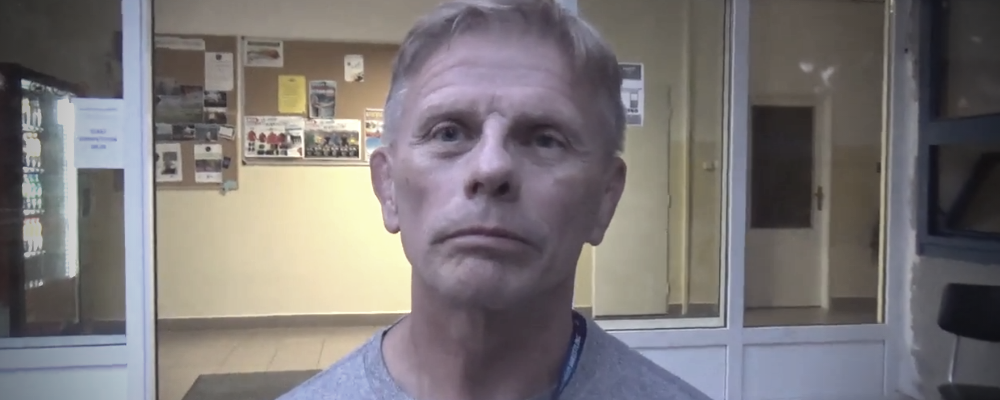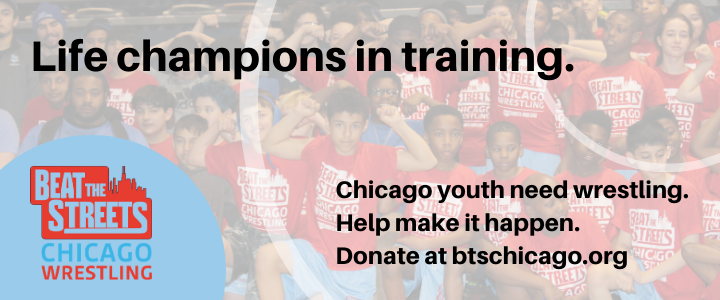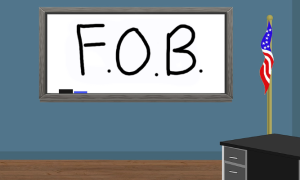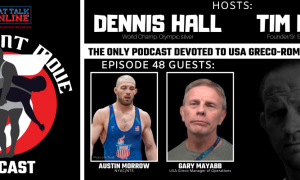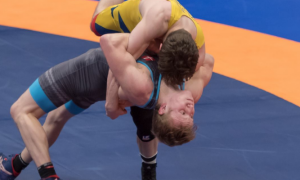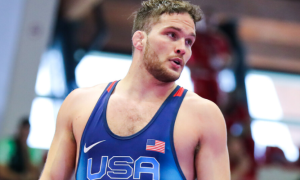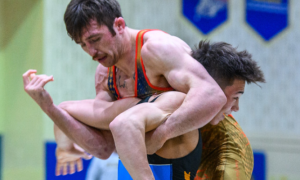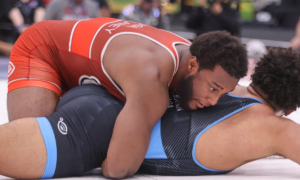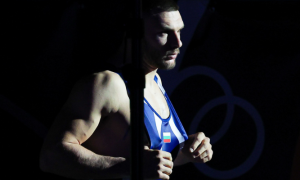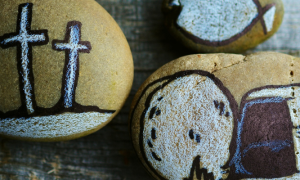Right about now, Gary Mayabb is concerned. Uneasy. Like most of us at the moment. He is also uncharacteristically subdued. Usually, a conversation with Mayabb begins with a few pleasantries, a couple of check-in questions to see how you’re doing, and then he is off and running. When you ask Mayabb a question, especially a question he likes, you don’t have to worry about where the energy is going to lead the conversation. So long as the man is switched on, regardless of subject matter, you are sure to be inundated with positive vibes. There is no other choice.
But on this night, Mayabb needs a pause or two at the outset. There is a lot to unpack. He was informed that the purpose of this piece was a sort of “state of the union” with regards to age-group Greco athletes. Mayabb, long a fixture as a coach on the national level, stepped in as the US Greco-Roman Manager of Programs just under three years ago. In that time, youth participation in Greco-Roman has healthily increased, international opportunities likewise, and the Juniors keep one-upping themselves on the World stage. What’s more, Mayabb has also played an enormous role in helping the US form a more cohesive relationship between youth coaches and the National Team staff at large, along with assisting USA Greco head coach Matt Lindland establish a new standard in communication with everyone from the Seniors on down the pecking order.
Mind you, this is just an overview of Mayabb’s achievements since 2017. What gets missed is the exhaustive film study, his love affair with spreadsheets, and lead-by-example adherence to “effort should always remain a constant”.
If life as we know it was at all normal — which it currently is not — Mayabb would need just a little primer to get his motor running ahead of some questions. Instead, the whole thing is wistful, as if we’re looking back on better days far off in the past, a different era when teenage wrestlers would be using the month of April to prepare for whichever World Team Trials event or Fargo qualifier. Just three weeks and some change prior, that’s what this conversation would have been about. And, Mayabb would have likely breathlessly laid out the training plan structure with an almost unreasonable amount of passion, we’d close the call, and I would get to work turning all of his dialogue into published words. I don’t mind, of course. Transcription is pretty much what I bring to the table.
Although, the plan did not deviate too much.
While it’s true that there are no upcoming competitive endeavors or training camps to discuss, you still have to press forward. Wrestling, in this case Greco-Roman wrestling, is not going anywhere. It is still a living, breathing thing, an eco-system that constantly requires nurturing and maintenance. Plus, as Mayabb pointed out, it is an outlet — and not just for the athletes but fans and family members, too. Our hearts are with those who are enduring anxiousness and pain, because to a degree, that story is the same for most everyone. But that is precisely why people need to know they have something to look forward to. They need to know that wrestling is still here for them. And you know what? So is Mayabb.
“I don’t pretend that wrestling is anywhere in the realm of what we’re going through as a nation right now. But we can find plans to become inspiring and truly appreciative. I’m respectful for how difficult it is. I mean, so many people have lost their jobs. Those kinds of things make it difficult in the middle of this to have these kinds of conversations. But you know me. As soon as you get me back into this little piece, all of the sudden it’s go-time.”
Hopefully, it will be go-time once again for everyone sooner rather than later.
Gary Mayabb — Manager of Greco-Roman Programs
5PM: You came on into this role in 2017. When you compare where we were at age-group-wise then to where we are now, have you liked the progress that has been made thus far, particularly when you think about what the US has done at Junior throughout this quad?
Gary Mayabb: I’m happy with it, but not satisfied. It was kind of neat about two weeks ago, right when we first got back from Canada. I dove into a study that was kind of a deep dive where I looked at (Ismael) Borrero (Molina) and I especially looked at (Kerem) Kamal of Turkey. I just wanted to go back and look at his Cadet matches and Junior titles, in relationship to what he looked like as a finalist at Senior Euros this year. At what point do these athletes need to be dialed in to their patterns of success? This is an area where we can make progress for our age-group athletes. The Juniors were ready, we need to use these deep dives to find solutions to our Cadet challenges. That hurt so badly last year, I really felt that we had done many of the right things with the Cadet Team. Man, our coaches did a great job — the coaches that went with us overseas, and the coaches who prepared these athletes out of their home base, they trained well and seem to travel well.
I just think everybody did their jobs and you are just trying to put your finger on what went wrong. It is one of those things where you start to think that you’ve got a little bit of the answer and then you get hit upside the head pretty hard. Two years ago we had 28 days between the time that we got the Team and the time we left with the Cadets. This past year, that was not the case. We had two months of preparation. So again, we felt we had a great camp and we thought we had our training camp at the right time, too. We had moved that one week earlier this year, but obviously that’s not going to happen now. But there’s good and bad to that (schedule). We were going to get our Cadet Team named in Vegas. You look, and right now we would be sitting 21 days out. That was going to give us some real time to get them in and work with them, do those kinds of things that we wanted to continue to do and make changes.
But looking at Kamal and all of his success, and what he and others did at the Cadet level before moving right onto the Junior and Senior levels, he had so many of the traits that our coaches want for our Seniors right now. And our Seniors have done a great job. Everyone was scoring points in all of the weights that were contested at the Pan Ams. It was just great. It has been a progression with our Seniors, but at age-group, because of the high turnover rate we are working on material right now that will hopefully improve their individual skills. As for the coaches in the United States who are working with our Cadets, we are very, happy with their efforts to move us forward.
5PM: This is the age-old, follow-us-around question, maybe more for U15 and Cadet currently: can we do more with folkstyle developmentally for Greco to where it is an advantage rather than a perceived disadvantage?
GM: One of the things that we’ve looked at is, helping our younger athletes make better contact choices in what we’re presenting to them tactically. What we’ve found is that there are several things that they are getting away with here when they’re wrestling domestically that they are not going to get away with internationally. Example: collar ties. I mean, thinking we’re going to put a collar tie on someone and drive it. There are certain things that we can do a better job of demonstrating for them, and again, by helping them make better first contact choices is what we need to reinforce.
I was working with some younger athletes here in Colorado, right before we went to Canada. When we talk with these athletes who are just coming into the Cadet range right now and you ask them, When you get into an over/under and begin pummeling, do you ever give up a bodylock, body attack, headlock, or arm spin? Yes, you do? Okay, well those are death moves. If you get thrown for four in a match, okay, you get back to your feet, but the chance of you winning unless you do something amazing, the kinds of things like (Kerim) Kamal does or some of these other great younger athletes who just unbelievably get on their horse and start right into the push-out, unless you do something radical like that, your not going to win– and if you do that but you’re not great at pushing, then you’re opening yourself back up — it’s going to probably end up a tech fall pretty quick.
We are looking at their decision-making. For example, two-on-one or an underhook. Let’s say their underhooks are good. What we find with most of our Cadets and U15 athletes who we’ve studied on film is that they may capture a pretty good underhook, and maybe they have a positive head position where their head is on the same side of the tie. But as we viewed, within a few seconds their position begins to deteriorate. Now, what was their startup threat or their attacking threat, has turned into a catch point for their partner or opponent in which they get caught and scored on out of their own tie.
Making better choices, and working with them on making really smart, consistent first contacts. Also, working below the pec line with their hands, keeping their hands as clean as possible so they can use them at their discretion without getting their elbows and hands trapped. Instead, keeping their hands inside the frame, inside the kill box that’s right at our pec line or high ribs. We want to do that without necessarily crossing our hands over the midline because when we do that, we can give up an automatic two-on-one.
One of the things we want to do is spend a lot of time on looking at what their tools are. Say you own a great gutwrench, and domestically every time you get this gutwrench you’re scoring points. Okay, then we want to find a takedown that will work for you, which means we’ll probably invest in a drag to reach-around or a knockdown, since that puts you in the spot you want to be so you can move right into your gut work. Or, you want to take ground so hard and drive opponents to get them put down (forced par terre) — but if you stay with that game, you better own great par terre defense because you’re going to get put down at some point, too. That is if all your points are coming from forced par terre. There is a good chance you’re going down, as well. We see a little bit of a trade there.
As coaches, we need to spend time on identifying what the athletes personal statistical strengths are, and then work with them getting to targets with their hands and converting targets to ties. This process will allow them to get more opportunities in creating an improved pathway to their Chaining Offenses. This would allow them to then operate in areas where they can generate lift and rotation.
We don’t have to reinvent the wheel. We need to align ourselves a little bit closer to what strengths they are bringing to the Greco fight. There are a lot of athletes who are very successful with bent defense on their feet, but you’ve got to take ground with it and it’s just hard to do without the hips being in and having your back being straight. It is really hard to create drive, so that’s one of those things that we’re going to try to mesh. If we could get them to maybe bend when they need to and head block a little bit, maybe we can help them get to a powerful capture position with their shoulders over hips more often. They will increase their functional posture, being capable of creating lift and rotational power.
Our U15 World Team, my goodness, they did such a great job of just letting things fly a little bit. They really had success in Budapest. There were a couple things that we had to tweak to help them live long enough in their ties. It was one of those lessons that we all learned from their efforts and should continue using down the road as they advance.
5PM: So you mention the U15 World Team from last year. A lot of those athletes came from places where the coaches themselves had either once been full-time athletes or have coached full-time athletes. Do you think that where we are now, in this era, that from U15 on upward we are going to start seeing more of an infusion of these youths choosing this style full-time?
GM: I hope so. It’s strange. These pockets of athletes were in four of the weight classes that were three deep, where if any of those three athletes came out (of the Trials), they would have done well. And then there were a couple of weight classes where they were two deep. So the question is how deep are we with those athletes you were describing? When you look at (Aden) Valencia, he is a full-timer. That guy, he doesn’t stop, he doesn’t slow down. (Paul) Kelly, he’s a goer. (Zach) Silvis, him, too. Their coaches and parents are outstanding.
5PM: Jadon Skellenger.
GM: Skellenger, my goodness, and Gavin Nelson. He got beat by a stud who got beat by a stud. It’s just the way it works out sometimes. Because then he comes back and wins Fargo, right? There is a group of guys who are very coachable right now, who have been coached by great coaches, and several from that Team have been influenced by several people. They have been sent to other places and their pedigrees expanded, even as young as they are, they’ve been around some really good coaches. I think that’s what we have to keep doing. We have to have coaches who share out and send their athletes to other places. Some of these athletes are very well-traveled. Joel Adams, he has been in full-time training environments like LOG (Legends of Gold). You blend this kind of experience, we will continue to improve.
And then within our Cadet program, so many of those coaches are tied into it. And their parents are also very well-traveled. They will pick up a phone and make a call, and their athletes are on the move, traveling somewhere, and working with coaches across the country. I’m hoping that this is one of those things we replicate, which is keeping them engaged and moving down a path. Recently, it was just trying to figure out what was available in that first year. The second year is starting to pinpoint some patterns, and then in Year 3, we have some athletes who are positioned to find out who their training partners are, and who is the next guy. We have to expand that richness. If we can expand it four or five deep, then now we are getting somewhere. To build that one guy who goes overseas.
5PM: U23 is usually not anyone’s favorite topic. In 2017 after everyone came back from the U23 Worlds, it was almost like a death.
GM: Right.
5PM: And the US has still not found success at this level, which is crazy because all three Teams thus far have had many of our best young full-time Seniors. One theory for these struggles is that U23 doesn’t get to separate themselves with a prolonged training plan. They have gotten one camp each year, basically. Part of that is also there have been collegians on the World Team, and then there is accounting for their scholastic responsibilities. But, each U23 Team has also been selected well in advance of their World Championships.
Gary Mayabb: Yeah, that’s true. U23, first of all, is a self-funded trip. We have been very fortunate in that several of those athletes were supported by major club systems, and that has helped an awful lot. We just haven’t seen the success come from that yet.
We have selected U23 Teams where they are all capable athletes. No doubt. But again, until we build the system with a little more depth. Right now, we are sending U23 athletes who have been strong at age-group and have made multiple Teams at multiple levels, many times in the same year. But what we’re looking at now is what would allow us to build more depth. We were convinced early on that it was a positive thing. Because, there are only x-amount of tournaments we can go to in order to gain the experience that this journey requires.
One of the things that happened that was very good for us at Juniors was Coach (Nate) Engel’s work. Nate took that group to Kourtane (Finland). They had a competition and training camp there, and it was half of the Junior World Team members. Then they returned home and came into a camp. That right there is one of the things you alluded to. One of the issues has been school for many of them, and how much time can we get. We have to look at the Team that we get and the geography in those areas, and see if we can get them together in small groups. Maybe bring in some training partners. If we can get that, maybe we can build depth as they advance.
Right now, and you know this, there are several of the Teams from other countries who have their #1 Seniors wrestling U23. It is a proving ground for them. For us, it is also a proving ground; but without the depth that we need, it is very hard to lock in a Team that will have enough high level training partners to set them up for success. We have to do a better job of that. We have to, we just have to. The time of the Championships is very difficult. We have some athletes who don’t go because it’s right before the season starts, or it has already started, and they are having dual meets with their college teams. That is another thing, we have to find a way to work with those coaches because we depend on their athletes.
Look at their NCAA training cycle. By late September, they are already starting to run a lot. They are deep in their strength-and-conditioning work. That is not the kind of thing in our best interest to try and peak these athletes to go to the U23 World Championships.
And that is certainly not a knock. If we go back and look at two items we’ve already talked about, one is building more depth at age-group and we had an 87% increase in participation at U23 World Team Trials last year. The second part of that is the athletes we get in there to build the depth, we get them overseas and work with them and set them up in some of these positions for U23. I’m not saying we don’t have the right people now. I’m saying we need to find more workers to be around the right people.
That is something we’re going to have to work very hard on. We had a plan where we were going to try and set-up some regional work this spring. Both Matt, myself, and other coaches were getting out on the road and working with these athletes early on in the summer.
5PM: We have had really good age-group World Teams the past few years, and you can count Junior last year even though those three (medalists) are Greco lifers.
GM: Yes.
5PM: But a good chunk of our age-group wrestlers are multi-style guys, especially at U15 and Cadet. What do you think the US brings to the table insofar as baseline attributes, even if they don’t have a ton of international experience? What do US kids who enter Greco and compete at Worlds have to offer as their best strengths?
GM: We are learning that the guys who have been doing it — and you referred to them as “lifers”, which is what they are — they have been entrenched in this. The guys who were successful, were offensively-countering. Not counter-offense, but offensively-countering, a concept in language that makes us think differently. Coach Zac Dominquez really helped in focusing on this mindset adjustment.
What we are talking about is there was going to be some technique that broke down at the end of that move, at the end of the threat, or the end of the attempt by their opponent. We know that the best time to score is either right after a score or right after an attempted score, by either person. It is something that Coach Lindland and the National staff has been working on with all of our athletes. Those lifers made it happen on the big stage. Look at Peyton (Omania) and Alston (Nutter) in their last two matches. They got scored on and came back immediately and scored on their opponents. That is something we are looking to really move down the road with right now. Their coaches, Mark Halvorson (CYC) and Andy Bisek (NMU), have done a great job with them.
The neat thing about that is it’s not a talent-based issue, it is a skill-based issue. That means these athletes are learning. They are in an environment where they’re learning and they’re practicing those scenarios, and those scenarios are showing up. Scoring is hard in Greco fights because of our ability to defend. You look at it, when you can’t attack below the waist. Our lines of defense — head, hands, and forearms — when you move your feet well, those three can shut down just about anything. Once the action starts, we are doing a much better job of offensive-countering. As our opponent is initiating an attack, we’re starting to think about what the end is going to look like. Whether we’re getting scored on or we’re scoring, that right there is something that we think really showed up with those Junior-level athletes.
I think that Matt’s direction for what he wants at the Senior level has a trickle-down effect. Some of this goes back to what we did in Las Vegas two years ago by putting four World Teams under one roof. The more that we can put these athletes together — because we have a relatively small population of “lifers” as you call them — we have to find more ways to do that, even if they are wrestling each other more often. When you can have 9, 10, 11 of the best Greco coaches in the country under one roof, and you have age-group coaches working with their athletes right next to our Senior athletes and all working together, those are the things we are starting to see that bring positive change. Otherwise, we’re just looking at their talent.
We are becoming risk takers. The risk takers can overcome a negative call; they can overcome a situation where maybe they didn’t get an opportunity on top par terre in the second period, so now they have to create a score. It comes back to figuring out how to create enough threats. Our athletes who were successful (at the Junior Worlds), they were risk takers. Their offensive-countering skills got better because they were creating scoring actions on the backside of attempts.
That is the biggest thing we can point to because it’s not solely-based on the talent of the athlete. It is based more on the learned skill-sets that our athletes are developing. In the past, that has not always turned out to be the best outcome we were looking for. The talented athlete has many needed gifts, as they make wiser choices on their targets and then really believe in themselves as risk takers they will create podium runs.
5PM: We have a ton of incredible young folkstyle wrestlers in the US. There has been a thought, Lindland is one who has thought this, so too has Kerry Regner, that many of these folkstyle wrestlers are really Greco wrestlers, but just don’t know it yet. When a kid asks you about Greco and how to get started — which I’m sure has happened to you millions of times — what are those conversations like, and what do you say?
Gary Mayabb: First of all, we don’t live in a vacuum. Folkstyle is doing so well right now. This whole thing that the national qualifiers are going through right now with the NCAA tournament supposed to have taken place in Minnesota, it is rightly overshadowed by the unfortunate parallels people in our country are going through. With Americans perishing in such large numbers, we all understand that it was absolutely the right thing to do, but my heart still goes out to those student-athletes and coaches who had prepared to do all of these things in front of what was going to be the largest audience of all time.
But, one of the biggest things is we have to find ways to work with these athletes and their talents. If you want to ride better (in folkstyle), you have to be able to lift and return wrestlers to the mat. Who does that better than Greco athletes when it comes to bringing their hips in? Those kinds of things we can see in folkstyle wrestlers, like a vertical level change, lift and two direct rotations made in one motion…
These things are sitting right there. Sometimes, they have raw abilities, they have honed those skills in folkstyle. Now, we’ve got to do a better job of illustrating why the tools, the ties, and the targets are so important. Because, if we could keep these athletes in a spot where their hands are clean and turn them loose at the right time in the match? I mean, that’s one of the things we saw out of the U15 group. If they could hand-fight well enough, they kept their hands clean, and kept their feet mobile and they could move into a position at their discretion and create lift and rotation? Man.
It’s both sides of this. One is that we have to look at what these athletes are displaying. My wife came back from announcing the NAIA tournament and told me, You have to look at these two guys. So we started looking at some film. Sure enough, very good hips, and good power to where they could drive somebody.
Whether it’s Greco or freestyle, one of the main areas of really building special athletes is when we twin-peak them. When we double-peak them in a year. If we want to just start naming great college wrestlers, then figure out how many of those guys were either making World Teams or attempting to make World Teams at Junior, U23 and even Senior levels, and then what success they had the following year at the NCAA’s. It’s not just a technical aspect. It’s tactical, it’s strategy, the preparation, the ability it takes to rethink and re-tool some of the skills that you have set — but in a slightly different way and do it six months apart.
If we have athletes coming out of high school peaking in February or early-March along with college athletes peaking at NCAAs — and then turning around again and peaking in November for U23 or September for Juniors? My goodness, it’s not just about the wrestling skills. It’s not about a leg attack. It is about learning how to successfully, efficiently fight. Those are tangibles that coaches don’t coach. We put them in the right environment and these athletes shine. And if we find the fighters? We should believe in our coaching skills enough to teach them folk, free, or Greco.
Listen to “5PM35: Pan Am Qualifier Recap” on Spreaker.
SUBSCRIBE TO THE FIVE POINT MOVE PODCAST
iTunes | Stitcher | Spreaker | Google Play Music
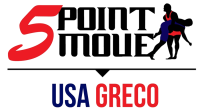
Notice: Trying to get property 'term_id' of non-object in /home/fivepointwp/webapps/fivepointwp/wp-content/themes/flex-mag/functions.php on line 999

